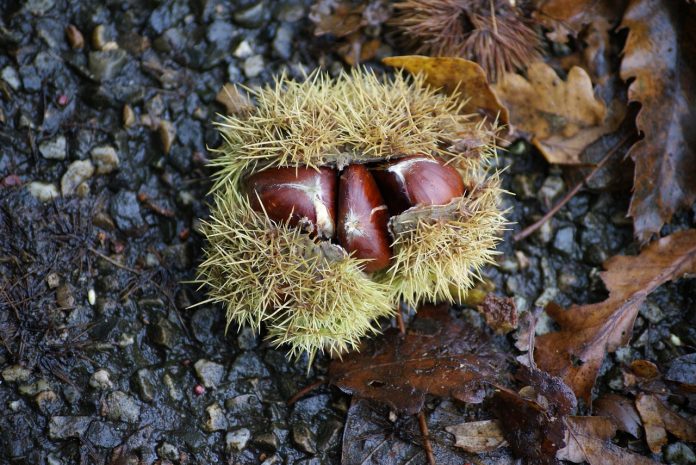When I was a boy, my father and I hiked country roads on autumn afternoons collecting hickory nuts, a favorite snack. One memorable fall day, my dad hopped into our ’57 Chevy and said, “Let’s take a ride.”
It was 1959. I was seven years old. As we drove, my dad explained, “I’m taking you to the woods where I collected nuts when I was your age. There were still a few chestnut trees, and I’d pull the dark brown nuts from their prickly burs.”
The fungus responsible for the chestnut blight was introduced in 1904 from China and had already killed off most of the chestnuts in the eastern forests, so Pop doubted we’d find any living chestnuts. “If we do,” he said, “the ground below will be covered with spiny husks. We called them porcupine eggs.”
Though the blight devastated chestnut populations, the tree is not extinct. In the 1800s chestnuts dominated the eastern deciduous forest. The Asheville, NC-based American Chestnut Foundation (ACF, www.acf.org) estimates that before the blight four billion chestnuts grew on more than 200 million acres of eastern woods from Maine to Georgia and west to the Ohio Valley.
Desirable tree
At its peak, the chestnut represented about one-quarter of all hardwoods growing across its range. The chestnut was a near perfect tree. It grew straight, tall, wide, and fast.
The wood was lightweight, rot resistant, and easy to work. Chestnut lumber was used for railroad ties, fence posts, and beams for barn and home construction. Aesthetically, the grain of chestnut boards was gorgeous.
And its nuts were favorite foods of squirrels, bears, deer, mice, turkeys, and people. Foresters and wildlife biologists could not have designed a better tree. Today chestnuts sprout from the remains of once healthy trees, but these sprouts are stunted and essentially worthless.
Functionally, oaks and their acorns have filled the niche vacated by chestnuts in eastern woods. Fortunately, the future of American chestnuts is bright. Founded in 1983, the ACF has been working for more than 30 years to develop a blight-resistant tree.
Restoring chestnuts
The goal is to restore blight-resistant American chestnuts to eastern deciduous forests. Chinese chestnuts are naturally resistant to the blight, so scientists have been crossing and backcrossing American Chestnuts with Chinese chestnuts at farms in Meadowview, Virginia.
It’s obviously a long-term process. To date, the selective breeding program has produced blight-resistant trees that are 15/16 American. When confident that their chestnuts are completely blight free, the ACF will make nuts available to the public for planting.
Of course, when I was seven, I knew nothing of the chestnut blight, but my father knew that healthy chestnuts were rare. I thought we were just looking for a nut we hadn’t seen before.
Finally, after about an hour of searching, we stumbled upon a carpet of chestnuts.
“I can’t believe it,” my dad exclaimed. “It’s been almost 25 years since I collected chestnuts here.”
Thanks to hungry squirrels, many of the husks were empty. We filled our pockets and headed home. Later that evening Pop threw some firewood on the burn pile, and we soon had “chestnuts roasting on an open fire.”
Holiday treat
He told me how much his mother had enjoyed freshly roasted chestnuts around Thanksgiving. The following year we returned to the same place, but there were no chestnuts on the ground. Maybe we were in the wrong spot, I suggested.
“No, this is the right place,” my dad said. “See the stump.”
The nut-bearing chestnut tree was gone. Someone had cut it down. It was the first and last chestnut tree I had ever seen. For purely selfish reasons, I felt cheated.
My dad sat down next to the stump, pulled me in, and put his arm around me. A tear ran down his grizzled, unshaved cheek. I was only eight years old, so I didn’t understand how a missing tree could make my dad cry. Now I do.













